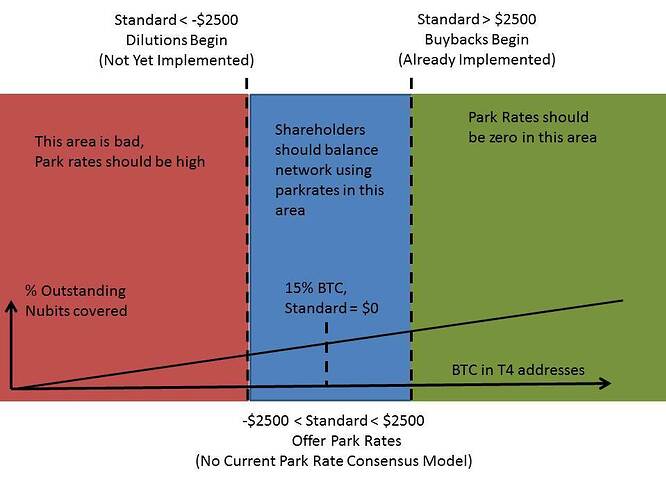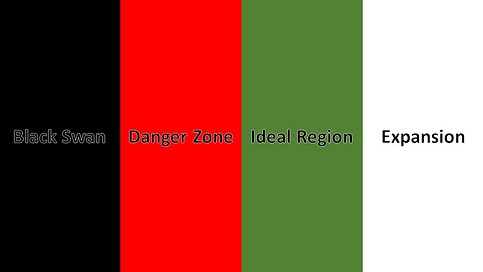Could you explain again how and when we are buying and selling NSR? I’m not sure I completely understand the mechanism your proposing.
How is up to FLOT. Basically, the how is not changed. The only thing this proposal spells out is when and how much. It actually doesn’t really change the buying of NSR (other than doing the ‘circulating nbt’ thing). What this motion does is reflect the point where we buy NSR about the 15% reserve point so that we have symmetry with when we buy and when we sell.
When the reserve goes above 15%, we sell. When it goes under 15%, we buy. When it’s near 15%, we play the park rate game. That’s the basic concept. This is in stark contrast to the current situation, where when we go below 15% we do nothing and wait for park rates to institute for a month before we sell a single share.
@dhume I think these are the most relevant points to your question:
The standard will act as a barometer for the health of Nu. It will be a number to rally support for consensus as far as when to implement park rates (putting official numbers and terminology to @JordanLee’s statement that a negative buyback number means we need to implement park rates). It will give the market confidence by providing a semi-predictable manner in which dilutions are done. It will give the network a greatly improved ability to react to NBT bank runs by falling back on NSR within 1 week (or less) instead of 1 month (or more) as is currently the case.
In short, it will provide a solid comprehensive basis for shareholders to begin talking about the health of the network using a single floating number: the standard. In a complex system run by semi-lucid shareholders simple rally points for consensus are vastly superior to a general gyst and feeling of impending doom.
Your last post helps everything make more sense. I was just wondering though. Is there a way to display this model visually with a simple diagram in paint maybe? It might help make it even clearer for shareholders if that could be successfully done.
After seeing this diagram and matching it with the text, it’s quite simple to chime in:
please hash it and let the voting begin!
It’s as simple and as efficient as it can be.
I once created a draft, hoping to get Nu in a similar direction, but your draft is so much more elegant!
Kudos!
I love this process of discovery! It’s like we’ve been given a newly invented instrument that’s never been played by anyone and it’s up to us to figure out all its finer details and quirks and tune it properly so it plays beautifully. This discovery process is going to take a lot of time and practice, but the results should hopefully be worth it in the end.
Thank you for explaining so eloquently, I will definitely vote for this proposal. Only thing I’m wondering about it that you didn’t specify the amount we buy or sell when we get below standard. Say we fall 20k USD worth below or above standard I’m assuming you don’t mean that we should try and sell/buy the whole amount at once? So would you propose to use the same 10% we are using at the moment? So we’re in excess of 20K BTC (aka 20k above standard) we start selling 10% a week? Same as for buying back BTC when we’re below?
So the standard is actually an abstract derived concept. Come next buyback, the standard (or buyback amount) will be 5% of (total btc reserves - 15% circulating nbt). So as you can see, with a 5% prefactor and a $2,500 standard threshold for buybacks and dilutions, we would need to be $50,000 in debt or in excess before we begin buying back or diluting at a $2,500/week rate.
The standard is not the deficit, it is the rate of change of the deficit. A $20k excess translates into a standard of only $400.
Maybe it is the wording, but you are saying that in the proposed bandwidth we are encouraged to institute park rates. Beyond the - 2,500 USNBT, I suppose it is a given to have park rates in place to support the peg. The more debt, the higher the park rates while limited NSR selling is working alongside and increasing, right?
At least that’s my understanding as well.
It finally creates a guideline for NSR holders when to raise park rates.
If the park rates aren’t able to remove enough NBT from the market temporarily for the reserve situation to recover, NBT need to be removed permanently by selling NSR.
What s the mathematical def of the standard?
I put the picture in the OP. I think it makes it clear that parkrates should be nonzero when the standard is less than $2,500.
I just noticed you spelled discretion wrong.
Added to encompass the discussion held here:
Why multiply the diff by 5%?
Cause otherwise it would be too big. The standard is the weekly velocity. This number is actually in the peercoin motion and already implemented, so the real answer is: because that’s how it is now.
Try to pay attention to the intracacies of this week’s buyback calculation. This motion only slightly changes the rules, most of the calculation is still the same.

